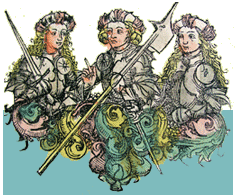Dum transisset Sabbatum
from Saturday, March22nd of the year2008.
Happy Holy Saturday. I am listening to as much Holy Saturday appropriate music as possible, including the insanely beautiful Lotti Crucifixus à 8, which is how I learned what a suspension was. This is the most insane piece of music and one of the most influential on my own output both sacred and secular. The choir begins by building up from the bass to the treble, each new voice introducing a new dissonance against the previous. After a calming resolution, the next episode is a sequence of constantly running eighth notes, a sequence of pulses, a reinforced muttering. The ascending suspensions of the first minute of the music return, upside-down, with mounting intensity. On the words, “passus et sepultus est” (he suffered and was buried), the highest voice ““ the climactic moment ““ resolves itself to a drone, a D suspended above the harmonic wiggling in the rest of the choir for three and a half bars. Singing this was one of the highlights of the liturgical year for me. I heard it yesterday at St. Thomas and am posting a recording here ““ sadly not theirs, but a really wonderful one:
[audio:Crucifixus.mp3]
Lotti Crucifixus ( Ã 8 )
Music for Holy Week
The Choir of King’s College, Cambridge
Another Holy Week delight is John Taverner’s Dum Transisset Sabbatum, which turns its attentions away from Jesus and instead towards Mary Magdalene, Mary, and Salome walking up the hill with spices to anoint Christ’s body. As is typical of Taverner, syllables are stretched out for as long as they will go, and the trebles are many miles above the altos, creating this vast, yearning space.
[audio:09 Dum Transisset Sabbatum.mp3]
John Taverner Dum Transisset Sabbatum
A Capella from Saint Thomas Church
Gerre Hancock, director
I went and saw Pétur GrÃmsson this week. I had been warned that the production was a little weird, and, yes, it was a little weird. Basically there was this dark wall that kept on moving forward and backwards. I don’t know. I guess it is way, way, cooler than first of all seeing the ocean (the music does a good enough job of describing that) and it didn’t look like a clam shack or a Red Lobster. In any event, did everybody fully process the awesomeness that is William Wegman’s interpretation of the opera?


7 Comments
March 22nd, 2008 at 5:59 pm
Hello and thanks for sharing this lovely music. The space between trebles and altos really does create a sense of 100ft ceilings.
I see that a piece of yours in on the program for next season at the Kitchener Waterloo Symphony and am quite looking forward to hearing it.
In fact, I may just mosey on over and purchase that album of yours.
All the best,
Miss Mussel
March 22nd, 2008 at 7:06 pm
No doubt singing “the great Dog and the Pleiades. . .”
March 22nd, 2008 at 8:41 pm
Velasquez did the same, Christ and Mary (Lazarus’ sister) in background and the focus on Martha and a cook frying some eggs.
The “aromatan” is an astonishing phrase, to ressurect must be a difficult task to deal with, in an Easter play ca.the 13th century, the “Noli me tangere” sounds in a mix of despair, dizziness and annoyance (I have an old version with Binkley).
March 23rd, 2008 at 7:13 am
Hey Nico, sorry I missed you at St. Thomas on Friday. Not only the Lotti, but the Victoria and Gesualdo during the Veneration were extraordinary. Wish I could hear “Jesus and the Whale” today, but I’ve already committed to going to Cathedral.
March 24th, 2008 at 2:52 pm
Would you please publish a sample of the organ concert? Thanks!
March 24th, 2008 at 8:02 pm
Post, not publish…or upload. Too many new verbs.
March 26th, 2008 at 10:16 pm
hey nico, I just wanted to give a congrats on the Easter anthem. I loved the solo soprano with the trumpet – it was a very lovely and unexpected sonority. anyways, I wanted to come by and say hi in person but I had to catch a train back home to DC.
best wishes!